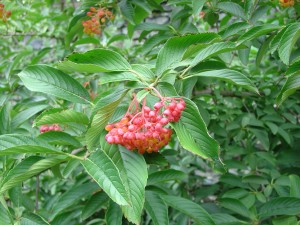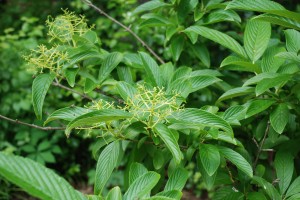The genus Viburnum is no stranger to U.S. gardens. Many species and cultivars of viburnums are popular. Siebold viburnum (V. sieboldii) is a large spring flowering species from eastern Asia (USDA hardiness zones 5-7), but is under-planted in today’s gardens. This multi-trunk large shrub to 12 to 15 feet high or 25 to 30 feet tall as a small tree.
This large, coarsely-textured shrub is covered with clusters of creamy white flowers in mid-spring (late May into June). Clusters of edible berry-like fruits (drupes) follow, each 1/3 inches in diameter; drupes eventually turn pinkish red starting in late August. Birds and other wildlife snap up the ripened black fruits fall into winter. The smooth light gray bark is a winter asset.
Dark green prominently veined leaves hang on long into autumn, eventually turning yellowish green before abscising. This naturally large multi-branched shrub is easily trained into a small tree and is a good choice for planting under power lines. Fashioning a young shrub into a small tree via pruning is not difficult.
Siebold viburnum grows and blooms more abundantly in full sun on a well-drained, moist, moderately acid soil. Two-year established shrubs are moderately shade and drought tolerant. It is rarely troubled by diseases and pests.
Plant enmasse to develop a tall hedge or thicket to shelter wildlife and provide them a feeding station.
Two cultivars of note:
Ironclad™ (‘KLMfour’) grow 15 feet tall and 12 feet wide with rugged foliage which gives striking coarse textured look
‘Seneca’ (U.S. National Arboretum introduction) is exceptionally hardy (zone 4) with lustrous dark green leaves that often hold on until late November.



 Posted in
Posted in 
